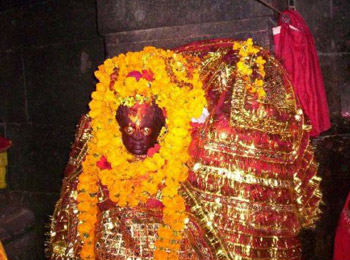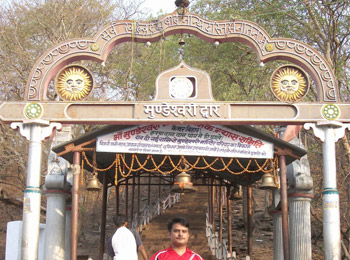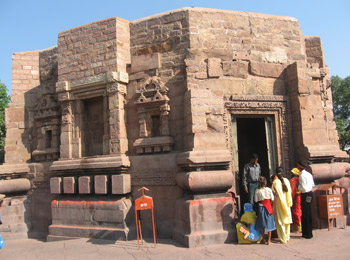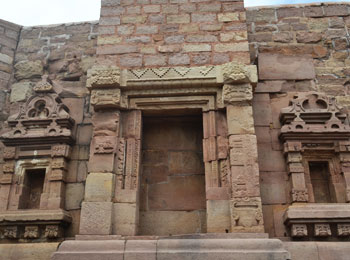- Shakti
Maa Mundeshwari temple
- Bhabua,Bihar
- View on map
- Tell us about this temple
Overview
The Maa Mundeshwari Temple is dedicated to Shakti. It is situated in Bihar, India. Located at the peak of Kaimur hills, the octagonal shaped temple was built in the 3rd century BC. Since then, the rituals have been taking place at Maa Mundeshwari temple, one of the oldest temples in India, without any disruption. One can witness Chatur Mukhalingam (Shiva Linga) with four heads at the centre.
About the temple

The shrine is known for its artistic liveliness and celebrated sculptures. Also the temple has separate praharas for Ganesha, Muruga, Vishnu and Bhooma Devi (Mother Goddess). Connoisseurs believe that the temple was built during the Shaka Era. Interestingly, the present doorkeeper of the site is a Muslim. The Mundeshwari Devi Temple (also spelled as Mundesvari) is located at Kaura in kaimur district in the state of Bihar, India on the Mundeshwari Hills. It is an ancient temple dedicated to the worship of Lord Shiva. Lord Shiva and Shakti and is considered one of the oldest Hindu temples in Bihar. It is also considered as the 'oldest functional' temple of world. The Mundeshwari Devi temple located on the Mundeshwari Hill at an elevation of 608 feet (185 m) is in Kaimur district of Bihar. The temple, built of stone, is on an octagonal plan which is rare. It is the earliest specimen of the Nagara style of temple architecture in Bihar. There are doors or windows on four sides and small niches for the reception of statues in the remaining four walls. The temple shikhara or tower has been destroyed. However, a roof has been built, as part of renovation work. The interior walls have niches and bold mouldings which are carved with vase and foliage designs. At the entrance to the temple, the door jambs are seen with carved images of Dvarapalas, Ganga, Yamuna and many other murtis. The main deities in the sanctum sanctorum of the temple are of the Devi Mundeshwari and Chaturmukh (four faced) Shiva linga. There are also two stone vessels of unusual design. Even though the Shiva linga is installed in the centre of the sanctum, the main presiding deity is Devi Mundeshwari deified inside a niche, which is seen with ten hands holding symbols riding a buffalo, attributed to Mahishasuramardini. The temple also has murtis of other popular gods such as Ganesha, Surya and Vishnu. A substantial part of this 7th century stone structure has been damaged, and many stone fragments are seen strewn around the temple. However, under the jurisdiction of ASI, it has been the subject of archaeological study for quite some time.It is believed that rituals and worship have been performed at the temple without a break and hence Mundeshwari is considered one of the most ancient functional Hindu temples in the world. The temple is visited by a large number of pilgrims each year, particularly during Ramnavami and Shivratri.
About the Deity

The presiding deity is Mahishamardini or Durga, with ten arms, killing an asura in the form of a buffalo.
Legend and stories

There was a certain Munda, whom people pretty generally call a Chera Raja; but the pandit of the survey says that he was a Daitya, who had a brother named Chanda, and both lived in the golden age. These brothers who, according to the Markandeya Purana, were the chief military officers (senaptis) of Sumbha and Nisumbha, two great infidel (Daitya) kings, were killed by Parvati, who on that account is called Chamunda, a title; it is said, composed of the two infidels' names. It is further said that the proper name of Chayanpur is Chanupur derived from one of the brothers who resided there, while a small temple named Mundesvari, and situated on a hill about five miles east from Chayanpur, was built by the Daitya Munda. If there is any foundation for the Puranic legend, it may refer to some exploits in the Indian warfare of Semiramis; but from the appearance of the ruins I have little doubt not only of the truth of the common report of Munda Raja having been a Chero but that he was some small chief, who retained a dependent principality long after his nation had ceased to possess the imperial dignity. The town where Munda resided is called Garohat, and was situated on the banks of the Katane, just in the eastern mouth of a valley formed between the great mass and the detached range of hills west from Bhagwanpur. The whole of this valley was originally called Mukeri Kho; but that name has of late been restricted to a large recess towards its east end, down which the Katane flows. The situation was judicially chosen for the residence of a person such as we suppose Munda to have been; as it is not only in a very rich country, but has behind it recesses in the mountains that are capable of defence by a small force; and even in case of defeat, the mountains afford a secure means of escape. It would appear from numerous heaps of bricks that the town of Garohat extended about 11 miles from east to west, and half a mile from north to south; it has not been fortified; but I believe that all the passes into the valley have been defended by lines. I thought that I could trace a very high rampart and wide ditch running in a straight line from the great mass of hills to the detached hill east from Bhagawanpur and in the pass between the latter and the detached hill next to it towards the west, at the village of Suraiya, has been collected some fragments of images called Hanuman, who at present is a favourite in that part of the country; but none of them have the smallest resemblance to a monkey. Three of them to resemble entirely, what in the ruins of the Behar Cheros were called Ganesa, Hargauri leaning on a bull and lion, and Narayana riding on Garuda.
A head also resembled that of the image called Vasudeva.The work, which by the vulgar are attributed to the Cheros, extended also all along the north side of the detached hills, both east and west from Garohat, where they have left several tanks and reservoirs, and some scattered images. Among these Rumajaya my native assistant, on the road between Majhar and Garohat, observed a Buddha seated in usual posture. The most remarkable of these detached works is, however, the temple of Mundesvarialready mentioned. Here the goddess is depicted with ten hands bearing, the usual weapons of a Mahisha- mardini but with the difference that she is not in the act of killing Mahishasura but is shown as riding a buffalo representing the demon . Mundesvari image is now the principal deity in the temple, which is visited by thousands who offer puja to the deity. It is, however, strange that the image of Mundesvari is found installed in one of the sub-chambers of the sanctuary and not at the centre of the cella, as is normally the case. A mukhalingam with four faces has been installed at the centre of the sanctuary of the temple, but this has not got the honor of being the presiding deity. Originally it was a Vaishnava shrine with Narayana as the presiding deity, succeeded near about Seventh Century A.D. by Shaivism and Vinitesvara, originally a subsidiary deity that became the pre-ready siding deity of the Place. In course of time, Mundesvari or a Mahisamardini image was installed when Shaktism had supplanted Shaivism. Mandalesvara clearly means the Lord or the presiding deity of the mandala (district or territory) and the ending isvara cannot have the same significance as it has in the names of Siva. Narayana mentioned in the inscription cannot be one and the same deity as Mandalesvara. With the passage of time the Goddess Mundesvari, originally a Parsva-devata in the Shaiva shrine of Vinitesvara, became the presiding deity of the temple, although she continues in the same position in the cella. The transposition appears to have taken place particularly during the time of the Cheros, a powerful aboriginal tribe who ruled over a portion of Shahabad for a long time.
Munda was a Chero king and Francis Buchanan and Martin were wrong in thinking that he had established the image of theGoddess Mundesvari. The aboriginal tribes in this part of the country are more prone to worship the female deities and there can be no wonder that Shaktism flourished with the Chero kings and the deity of Mundesvari, representing Shakti, came to be worshipped as the principal deity of the temple, where she was a minor image at one time. The mukhalingam, which was still in the central position of the cella, was relegated to a minor position. The history of the temples in India shows that very few images installed in the central position have been subordinated to other deities fixed in the niches. It is also remarkable that this temple appears to have been left unmolested when Muslim rule under Sher Shah was set up in this area. The neighboring Chayanpur fort was one of the citadels of Sher Shah and the Muslim pockets in the neighboring villages suggest that a much larger Muslim population had lived in the area when Muslim rule was predominant. The ravages to Mundesvari temple are not man-made but due to the passage of time. A big annual fair (mela) is held near the Mundesvari temple during the Navaratra. Buchanan Hamilton has mentioned in his memoirs that "about 2000 votaries assemble here at a fair (mela) ". Now the mela is visited by even more than ten thousand persons. Mundesvari temple is an important landmark in the story of temples in Bihar, being the oldest in age and the only specimen of Nagara architecture, as also because of the transposition of the prestige of the deities that has already been discussed. The area is well worth a visit and possibly excavation. It is true the sikhara of the temple is not in existence but a fragment of the amalaka (fluted finial) originally crowning the spire is still lying in the site. Round about the temple there are several half-amalakas. It may be safely presumed that the bhumi-amalakas had originally been used on the spire of the temple.
From this point of view, the Mundesvari temple stands comparison with the Parasuramesvara temple at Bhuvaneswar in Orissa. The exact height of the vertical portion of the temple, at which the ceiling was originally constructed, cannot now be ascertained. According to the commonly accepted story, which was also mentioned by Buchanan and Martin, Munda, the brother of Chanda, had established the goddess Mundesvari. Dr. Panigrahi rightly finds nothing, unusual in the name, as there are names of deities like Varun- esvara, Indresvara, etc. The real history of the shrine was apparently forgotten and the people came fondly to believe that Munda established the Goddess. Mundesvari or Parvati originally was installed as one of the three images in three sub-chambers of the sanctuary with the mukhalingam as the centre as indicated in Martin's plan in his Eastern India. But Mundesvari image, somehow, came to be preserved while the images of Kartikeya and Ganesa, the two other images in the niches, have been lost. It may be mentioned here that a large image of Ganesa is found half buried in the ruins of a small temple in the way leading to the top of the hill and might have been one of the Parsva-devatas originally enshrined in one of the side chambers of the Mundesvari temple.
Festivals

Of particular significance is the period of Navratra when thousands of people from the Rohtas, Gaya, Aurangabad, Bhojpur, Varanasi, Mirazpur and surrounding districts of Bihar and Uttar Pradesh districts come to the temple and a mela is held. During this period, the temple and the area around the hill is a riot of colour. The guest house at the base of the hill, the concrete road up the hill, the sodium vapour lamps lighting up the temple and the hill road in the night and the market complex built for the mela have brightened up the whole environment recently.
Accessibility
Mundeshwari is a holy shrine in Kaimur district in the Indian state of Bihar. It is 22 km by road south of the city of mohania, in Kaimur district at the intersection of State Highway 14 and National Highway 2. NH-30 also originates from Mohania. Transport Babhua road is also name as Mohania which is well connected by air, rail and road with the major Indian cities like New Delhi, Mumbai, Kolkata, Chennai, Pune, Ahmedabad, Indore, Bhopal, Bhubaneswar, Gwalior, Jabalpur, Ujjain, Jaipur, Patna, Jamshedpur, Secunderabad etc. It is 776 km from Delhi. It is 1240 km from Secunderabad. One of the major factors in Mohania's sustained existence as an inhabited city is its role as an established transportation hub between different cities. The town is 180 km from Patna and 60 km from Varanasi by road. It is subdivisional town in Kaimur district. The district headquarters, Bhabua, is 14 km southward from the railway station.
Road
• National Highway 2 (G.T. Road) crosses through the heart of the city.
• National Highway 30 originates from this city and connects with the capital Patna via Arrah.
Apart from these, there are also a few State Highways in the city. Mohania is connected to Bauxar via Ramgarh from the south and with Bhabua (district capital, Audhaura, Bhagwanpur) from the south Railway.
The name of the railway station of Mohania is "Bhabua Road", situated on Howrah–Gaya–Mughalsarai–New Delhi Grand Cord line. The station code is "BBU". Airport Lal Bahadur Shastri International Airport, Varanasi, commonly known as Babatpur Airport, is the nearest airport, 71 km from Mohania.
All the major domestic Indian carriers, including Air India, Jet Airways, Kingfisher Airlines, Spicejet, and international carriers like Air India, Mihin Lanka, Thai Airways International, Korean Air and Naaz Airlines, operate from here. The Airport handled more than 5.50 lakh passengers per year.
Address
Maa Mundeshwari Mandir
Mundeshwary Dham Marg,
Paunra,
Kaimur, Bihar 821102
Significance
Devotees visit this temple to seek fulfillment of the following:-
- To get rid of the ill effects from enemies
- To attain mental peace
Shlokas
Sarva Mangala Maangalye Sive Sarvaardha Saadhike, Saranye Tryambake Gauri Naarayani Namosthuthe
Meaning -We offer you our salutations, Oh auspicious Naraayani, who is the good of all good, who can achieve everything and can offer refuge, Oh three-eyed Gowri.
Saranaangatha Dheenaartha Parithraana Paraayane Sarvasyaarthi Hare Devi Naaraayani Namosthuthe
Meaning -We offer salutations to you, Oh Narayani, who has the infinite power of creating, preserving and destroying. You are the basis and epitome of the 3 gunas.
Sarvaroope Sarvese Sarvasakthi Samanvithe, Bhayebhyastrahi No Devi Durge Devi Namosthuthe
Meaning -I offer my salutations to you mother Durga, who is present in all beings and has all power, save us from all our wrongdoings O mother of the universe.
Yaa Devi Sarva Bhooteshu Shakthi Roopena Samsthita Namastasyai Namastasyai Namastasyai Namo Namaha
Meaning -Salutations to the Goddess who resides as Shakti in all beings.
Timings
6 a.m. to 6 p.m.
